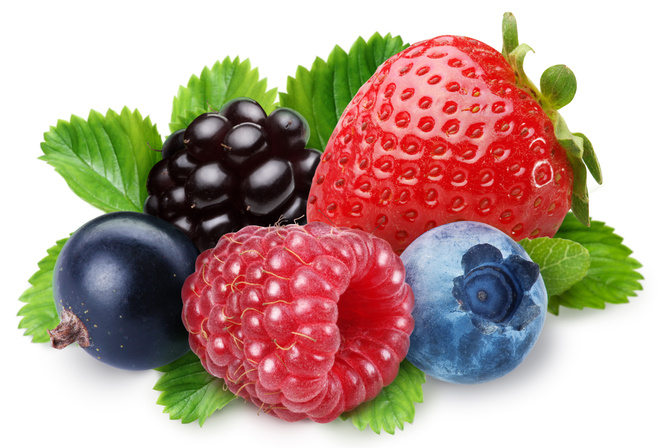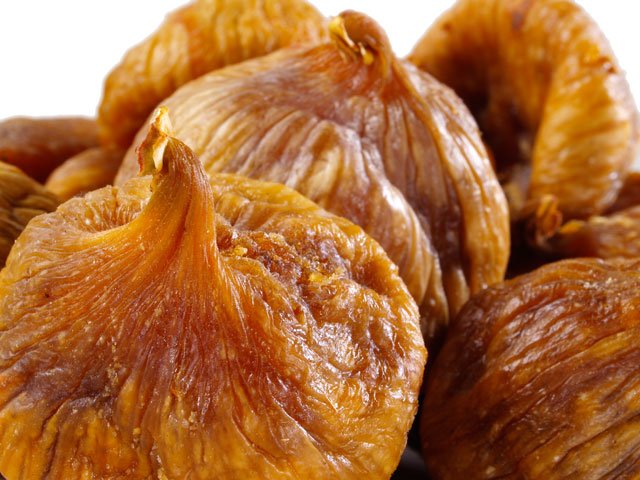[Article] The top 25 healthy fruits: Blueberries, apples, cherries, bananas and 21 more healthy picks.
By Cara Rosenbloom, RD
This story was originally titled "A Glossary of Healthy Fruits," in the March 2008 issue. Subscribe to Canadian Living today and never miss an issue! Few
things compare to the sweetness of fresh-picked strawberries or the
luscious first bite of watermelon that leaves juice dripping down your
chin.
Fruits are not only delicious but healthful too. Rich in
vitamins A and C, plus folate and other essential nutrients, they may
help prevent heart disease and stroke, control blood pressure and
cholesterol, prevent some types of cancer and guard against vision loss.
They're so good for you that Health Canada recommends that most women
get seven or eight servings of fruit and vegetables each day.

If
it's the vitamins that promote good health, you may wonder if you can
just pop supplements. Nope. Sun-drenched peaches and vine-ripened grapes
contain more than just vitamins; they're a complex combination of
fibre, minerals, antioxidants and phytochemicals – as well as the
vitamins – that work in combination to provide protective benefits.
You can't get all that from a pill.All
fruits offer health benefits, but the following 25 stand out as
nutrient-dense powerhouses with the most disease-fighting potential. (
Note: Only the best sources of each vitamin, mineral and antioxidant are listed in the "nutritional value" section.)
Apple • Nutritional value (1 medium): 75 calories, 3 g fibre
• Disease-fighting factor: Apples contain antioxidants called flavonoids, which may help lower the chance of developing
diabetes and asthma. Apples are also a natural mouth freshener and clean your teeth with each crunchy bite.
• Did you know?
An apple's flavour and aroma comes from fragrance cells in apple skin,
so for maximum flavour, don't peel your apple. Plus, the vitamins lie
just beneath the skin.
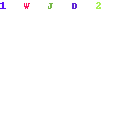 Avocado
• Nutritional value ( ½ avocado):
Avocado
• Nutritional value ( ½ avocado): 114 calories, 4.5 g fibre, source of vitamin E and folate
• Disease-fighting factor:
Avocados contain healthy monounsaturated fats that can help lower
cholesterol levels when eaten instead of harmful saturated fats. For a
heart-healthy boost, replace butter with avocado on your favourite
sandwich.
• Did you know? Babies love avocados.
Their soft, creamy texture makes them easy to eat, and their high fat
content helps with normal infant growth and development.
Banana • Nutritional value (1 medium): 105 calories, 3 g fibre, source of vitamin B6, potassium and folate
• Disease-fighting factor: With 422 milligrams of potassium per banana, these sweet delights have more
potassium than most fruit and may help lower blood pressure levels.
• Did you know?
People with rubber latex allergies may also be allergic to bananas
since the two come from similar trees and share a common protein.
Blackberry
• Nutritional value (1/2 cup/125 mL): 31 calories, 4 g fibre, rich in antioxidants
• Disease-fighting factor: Blackberries
get their deep purple colour from the powerful antioxidant anthocyanin,
which may help reduce the risk of stroke and cancer. Studies show that
blackberry extract may help stop the growth of lung cancer cells.
• Did you know? The ancient Greeks called blackberries "gout-berries" and used them to treat gout-related symptoms.
Blueberry• Nutritional value (1/2 cup/125 mL): 41 calories, 1.5 g fibre, rich in antioxidants
• Disease-fighting factor:
Blueberries rank No. 1 in antioxidant activity when compared to 60
other fresh fruits and vegetables. Blueberries may help lower the risk
of developing age-related diseases such as Parkinson's and
Alzheimer's.
• Did you know?
Blueberries freeze very well. Here's how: Rinse, then let berries dry
in a single layer on towels. Freeze in a single layer on rimmed baking
sheets. Seal in freezer-safe containers for up to one year. Use them
straight from the freezer in your morning cereal, blend them into a
smoothie or mix into pancake or muffin batter. (You can also buy frozen
blueberries year-round.)
The serving size listed for each fruit
in our glossary counts as one serving in Canada's Food Guide. The number
of servings you need each day depends on your age and gender. For
example, women between the ages of 19 and 50 need seven to eight
servings of fruit and vegetables each day (three fruit and four
vegetable servings would suffice). To determine the correct number of
vegetable and fruit servings for you, visit the Health Canada website (
www.hc-sc.gc.ca) at and search for "food guide."
Cantaloupe
• Nutritional value (1/2 cup/125 mL): 25 calories, less than 1 g fibre, source of vitamin A, folate and potassium
• Disease-fighting factor:
Cantaloupe is high in the antioxidant beta-carotene, which may help
reduce the risk of developing cataracts. Cantaloupe is a perfect diet
food since it has about half the calories of most other fruits.
• Did you know? Since bacteria can grow on the outside rind, it is important to wash cantaloupe before cutting into it.
Cherry• Nutritional value (1/2 cup/125 mL): 46 calories, 1.5 g fibre, rich in antioxidants
• Disease-fighting factor: Sour cherries contain more of the potent
antioxidant anthocyanin than any other fruit. Anthocyanin may help reduce inflammation and ease the pain of arthritis and gout.
• Did you know?
Sour cherries, commonly used in pie and jam, have more vitamin C than
sweet cherries do, but much of it is lost when they are heated.
Cranberry• Nutritional value (1/2 cup/125 mL): 25 calories, 2.5 g fibre, rich in antioxidants
• Disease-fighting factor: Cranberries are antibacterial
and studies show that they can help treat and prevent urinary tract
infections. Recent research has also linked cranberries to the
prevention of kidney stones and ulcers.
• Did you know? Unsweetened cranberry juice makes an excellent mouthwash – studies show it can help kill bacteria and fight cavities.
Dried Figs
• Nutritional value (2 dried figs): 42 calories, 1.5 g fibre, source of potassium, calcium and iron
• Disease-fighting factor: High in fibre, figs may help reduce the risk of heart disease.
• Did you know?
Puréed figs make an excellent substitute for fat (like butter or oil)
in baked goods. Simply purée 1 cup (250 mL) of dried figs with 1/4 cup
(50 mL) of water, then replace half of the fat called for in the recipe
with an equal amount of the fig mixture.
 Goji berry
• Nutritional value (1/2 cup/125 mL):
Goji berry
• Nutritional value (1/2 cup/125 mL): 90 calories, 2.5 g fibre, source of vitamin A,
rich in antioxidants
• Disease-fighting factor: Goji
berries are a nutrient powerhouse, containing six vitamins, 21 minerals
and a slew of antioxidants. They have been linked to the prevention of
diabetes and cancer, but more research is needed to understand their
effects.
• Did you know? Dried
goji berries, which look like dried cranberries, can be found in most health food and bulk stores.
Note:
Health Canada has warned people using the prescription drug Warfarin to
avoid goji berries, because they can alter the drug’s effectiveness.
Frozen fruitIf your favourite fresh fruit is only
available for six weeks of the year, head to the frozen food aisle.
Grocery store freezers house a variety of affordable frozen fruit,
ranging from cubed mango to woodland blueberries to tropical fruit
salad.
Not only is frozen fruit convenient, but it's also equally
nutritious – if not more so – than its fresh counterpart. Fresh fruit
starts to lose nutrients as soon as it's picked. The time between
harvest and consumption can be long enough for significant nutrient
losses to occur. Frozen fruit, however, is picked and frozen
immediately, retaining much of the nutrient value. Plus, since frozen
fruit is already washed, peeled and cut, it's a breeze to use. It can be
thawed at room temperature or defrosted in the microwave. Once
defrosted, eat it as you would fresh fruit, or use it atop cereal, mixed
in yogurt or blended into
smoothies.
Grape• Nutritional value (1/2 cup/ 125 mL): 53 calories, less than 1 g fibre, source of manganese
• Disease-fighting factor: Grapes contain resveratrol, an antioxidant that may help prevent
heart disease
by reducing blood pressure levels and lowering the risk of blood clots.
Resveratrol may also help stop the spread of breast, stomach and colon
cancer cells.
• Did you know? You can freeze red
and green grapes and use them as colourful ice cubes in your favourite
drinks. They add a special touch to sparkling water or Champagne.
 Grapefruit (pink)
• Nutritional value (1/2 grapefruit):
Grapefruit (pink)
• Nutritional value (1/2 grapefruit): 52 calories, 2 g fibre, source of vitamin A
• Disease-fighting factor:
Pink grapefruit contains lycopene and flavonoids, which may help
protect against some types of cancer. Grapefruit also boasts an ample
supply of pectin, a soluble fibre that may help lower cholesterol
levels.
• Did you know? Grapefruit can heighten the
effect of certain drugs, including cholesterol-lowering statins. Check
with your pharmacist to see if grapefruit may interfere with any of your
medications.
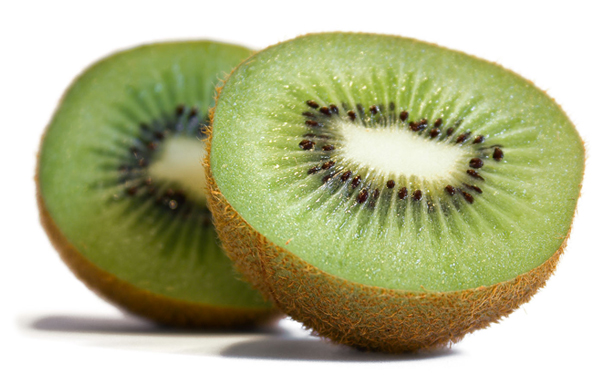 Kiwifruit
• Nutritional value (1 large):
Kiwifruit
• Nutritional value (1 large): 56 calories, 3 g fibre, source of vitamins C and E, and of magnesium and potassium
• Disease-fighting factor: With more
vitamin C
than oranges, kiwis can help in the development and maintenance of
bones, cartilage, teeth and gums. They can also help lower blood
triglyceride levels (high triglycerides increase the risk of heart
disease).
• Did you know? Most people remove the fuzzy skin, but kiwis can actually be eaten whole – skin and all.
Mango• Nutritional value (1/2 medium): 54 calories, 1.5 g fibre, source of vitamins A and E
• Disease-fighting factor:
Mangoes are high in the antioxidants lutein and zeaxanthin, which may
help protect vision and reduce the risk of age-related macular
degeneration (the leading cause of blindness in adults).
• Did you know? Mangoes can be enjoyed ripe as a sweet, juicy dessert choice or unripe as a sour, crunchy addition to chutney and
salads. Orange• Nutritional value (1 medium): 62 calories, 3 g fibre, source of vitamin C, folate and potassium
• Disease-fighting factor:
Oranges are a good source of folate, an important vitamin for pregnant
women that can help prevent neural tube defects in their infants. They
also contain a phytochemical called hesperidin, which may lower
triglyceride and blood cholesterol levels.
• Did you know? The edible white part of the orange rind has nearly the same amount of vitamin C as the flesh, so eat that part too!
Papaya• Nutritional value (1/2 medium): 59 calories, 3 g fibre, source of folate, vitamins A and C
• Disease-fighting factor: Papayas contain papain, an enzyme that aids digestion. Plus, their high vitamin A content aids in maintaining the health of the skin.
• Did you know?
The black seeds inside the papaya are edible and have a sharp, spicy
flavour. Try blending them into salad dressing as a substitute for black
pepper.
Peach• Nutritional value (1 medium): 58 calories, 2 g fibre, source of vitamin A
• Disease-fighting factor: High in vitamin A, peaches
help regulate the immune system and can help fight off infections.
• Did you know? Peaches do not get any sweeter once they have been picked, so avoid buying underripe peaches.
Pear• Nutritional value (1 medium): 96 calories, 5 g fibre
• Disease-fighting factor: Much
of the fibre found in pears is soluble, which can help prevent
constipation. Soluble fibre may also help reduce blood cholesterol
levels and prevent heart disease.
• Did you know? Unlike
most other fruits, pears don't ripen well on the tree. Instead, pears
are harvested when mature and are allowed to finish ripening under
controlled conditions.
Pineapple • Nutritional value (1/2 cup/125 mL): 40 calories, 1 g fibre
• Disease-fighting factor:
Pineapple contains a natural enzyme called bromelain, which breaks down
protein and helps aid digestion. Bromelain may also help prevent blood
clots, inhibit growth of cancer cells and speed wound healing.
• Did you know? Since bromelain breaks down protein, pineapple juice makes an excellent marinade and tenderizer for meat.
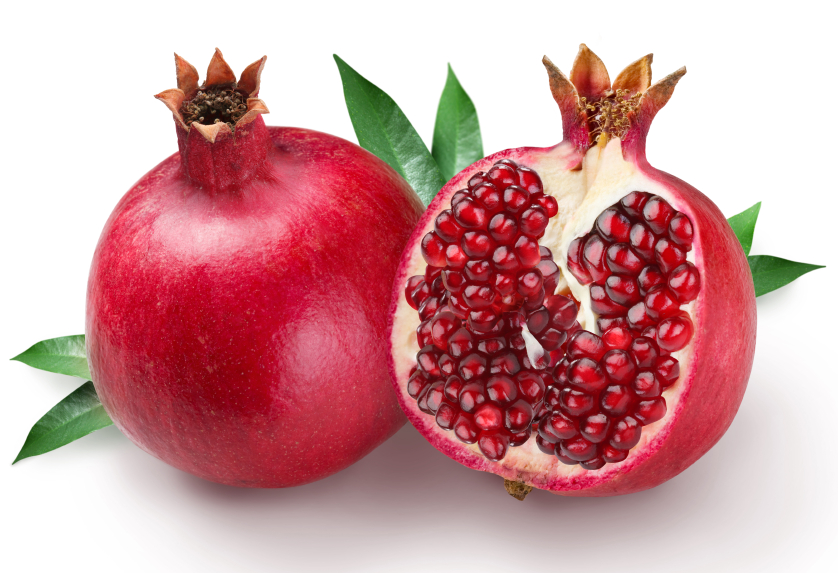 Pomegranate
• Nutritional value (1/2 fruit):
Pomegranate
• Nutritional value (1/2 fruit): 53 calories, less than 1 g fibre, source of vitamin A and potassium
• Disease-fighting factor: Pomegranates
contain antioxidant tannins, which may protect the heart. Studies show
that daily consumption of pomegranate juice may promote normal blood
pressure levels and reduce the risk of heart attacks.
• Did you know? Pomegranates
contain glistening, jewel-like seeds called arils that can be pressed
into juice. One medium pomegranate yields about 1/2 cup (125 mL) of
juice.
Prune • Nutritional value (3 prunes): 60 calories, 2 g fibre, source of vitamin A
• Disease-fighting factor: Prunes are a source of the mineral boron, which may help prevent
osteoporosis. Prunes also impart a mild laxative effect due to their high content of a natural sugar called sorbitol.
• Did you know? Marketers in the United States are trying to legally rename prunes "dried plums" to appeal to a younger market.
 Raspberry
• Nutritional value (1/2 cup/125 mL):
Raspberry
• Nutritional value (1/2 cup/125 mL): 32 calories, 4 g fibre, source of folate and magnesium
• Disease-fighting factor: Raspberries are rich in ellagic acid, an antioxidant that may help prevent
cervical cancer. Promising studies in animals have led researchers to believe that raspberries may also help treat esophageal and colon cancer.
• Did you know?
Raspberries are so perishable that only three per cent of Canada's
raspberry crop is sold fresh. The remaining berries are used to make
jam, baked goods and other delicacies.
Strawberry • Nutritional value (1/2 cup/125 mL): 23 calories, 1.5 g fibre, source of vitamin C
• Disease-fighting factor: Strawberries are rich in several antioxidants that have
anti-inflammatory properties, including helping to prevent
atherosclerosis (hardened arteries) and to suppress the progression of
cancerous tumours.
• Did you know? The flavour and
colour of strawberries is enhanced by balsamic vinegar. For a fabulous
dessert, drizzle balsamic vinegar over ripe strawberries and serve with
vanilla ice cream.
Tomato • Nutritional value (1 medium): 22 calories, 1.5 g fibre, source of vitamin A, folate and potassium
• Disease-fighting factor: Tomatoes are nature's best source of lycopene, a potent antioxidant that may help
reduce cholesterol levels and protect against advanced-stage prostate cancer.
• Did you know?
Tomatoes cooked with a touch of oil provide more lycopene than raw
tomatoes, so a rich tomato sauce made with olive oil is a healthy
choice.
Watermelon • Nutritional value (1/2 cup/125 mL): 23 calories, less than 1 g fibre, source of vitamin A
• Disease-fighting factor: Watermelon
is 92 per cent water, making it aptly named. It's a great addition to
any weight-loss diet because it is low in calories and satisfies the
sweet tooth.
• Did you know? Watermelon rinds and
seeds are both edible. Roasted, seasoned seeds make a great snack food,
and the juicy rind can be stir-fried, stewed, or pickled.
Glossary Phytochemicals:
Most of the more than 1,000 known phytochemicals have antioxidant
properties that help protect our cells against disease-causing damage.
Phytochemicals are often identified by their colour (for example, the
purple-hued anthocyanins in blackberries and the red lycopene in
tomatoes). Each colourful phytochemical provides a different health
benefit to the body, so for the best protection against a variety of
diseases, choose an array of colourful fruits each day.
Free radicals:
Harmful molecules that occur naturally in the body or that come from
pesticides, pollution, smoking and radiation. They damage the body's
cells, which can lead to cancer and heart disease.
Antioxidants:
Powerful substances that can protect the body against the harmful
effects of free radicals. Some of the vitamins, minerals and
phytochemicals found in fruit can act as antioxidants.


